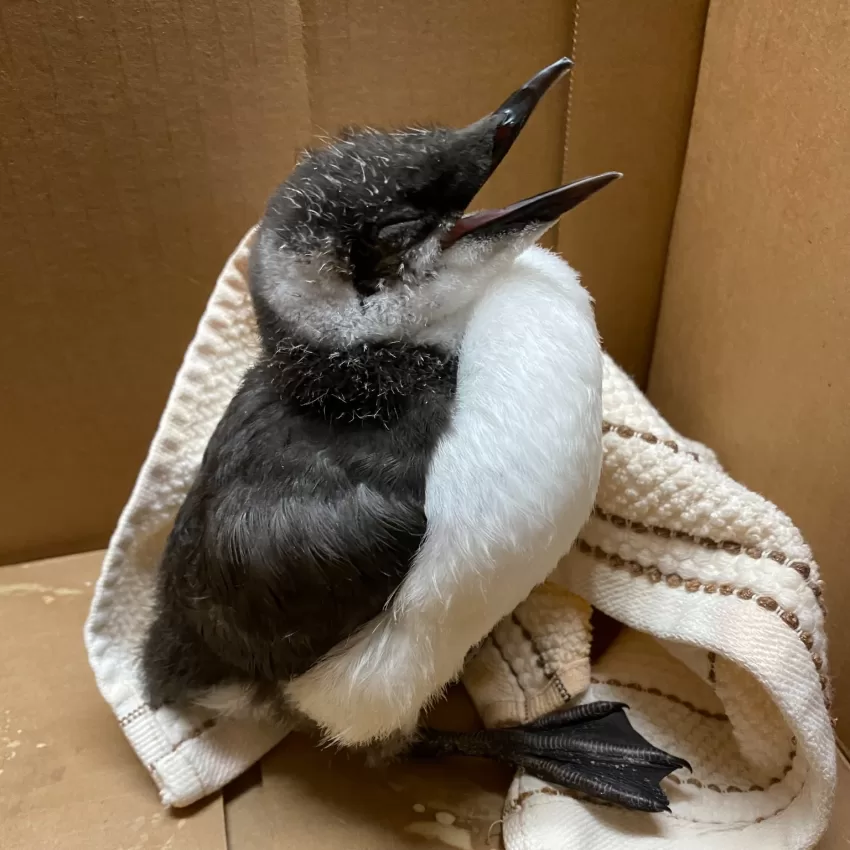With the ODFW announcement yesterday requesting that the public not handle, “leave alone”*, common murre chicks (jumplings – see below for more information.) The Pioneer reached out to the Wildlife Center of the North Coast because we had other information that indicated that WCNC would indeed rehabilitate murres and other seabirds. In Clatsop and Tillamook Counties the public is encouraged to call the Wildlife Center to report these stranded birds.
The Wildlife Center of the North Coast is intaking seabirds (including common murres) and all other native birds for rehabilitation. However, the center is only permitted to take in birds found in Clatsop and Tillamook counties to prevent the spread of HPAI. If you find a stranded seabird in these counties, the individual is encouraged to call the Wildlife Center. If found outside these counties, the individual is directed to contact their local ODFW office.
The Wildlife Center will be taking in murres for rehabilitation until they are directed otherwise.
We want to be sure that members of this community know that birds found within these areas are still candidates for rehabilitation.
If you have any questions, please reach out to the Wildlife Center Ph: 503-338-0331 or info@coastwildlife.org
Ginger Nealon, the Rehab Coordinator and licensed rehabilitator here at WCNC replied to our inquiry: Rehabilitation is certainly an option for murres of any age! When fledgling (or “jumpling”) murres wash up on the beach, they almost always are in need of care. When they fledge, they jump off of their nesting site (on a cliff) and land in the water below, where the male parent teaches them how to forage for fish. Murres that wash up on the beach (due to weather/sea conditions, general weakness, lack of food supply, loss of waterproofing, etc) are unlikely to recover and get back out in the water – they have likely exhausted their energy and will not survive if left alone. We strongly encourage anyone who finds a murre (fledgling or adult) on the beach to call us! Murres are one of our most common species treated at our clinic – we rescue, rehabilitate, and release murre jumplings every year, and we can’t do it without the help of the public.
Hope that’s helpful info – we absolutely want folks to call the center (503-338-0331) if they see birds in distress.
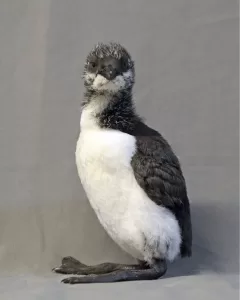
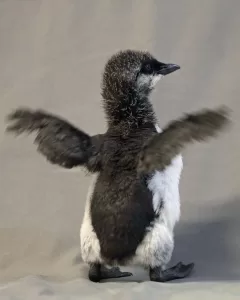
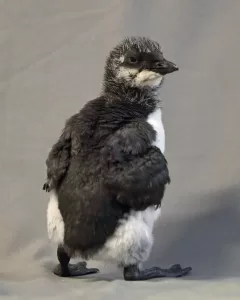 The cutest model ever. This little one likely took an early tumble from its nest, but fear not–our team is now giving it all the care it needs to thrive!
The cutest model ever. This little one likely took an early tumble from its nest, but fear not–our team is now giving it all the care it needs to thrive!
It’s that special time of year – “Jumpling Season”! These adorable Common Murre chicks jump flightless from their nests, and some need a little patching up along the way. That’s where our team steps in! If you spot a jumpling on the shore, reach out to our wildlife hotline at 503-338-0331. The Wildlife Center of the North Coast is a nonprofit – for more information go to www.coastwildlife.org.
Here is more from Seaside Aquarium:
It’s jumpling season!
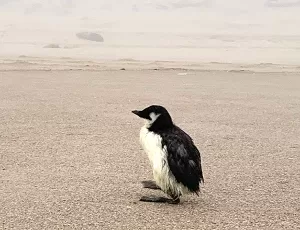
Visitors to the Oregon Coast often mistake common murres for baby penguins! Their tuxedo plumage and upright posture make them seem like they could be the penguin’s Northwest cousin, but the common murre actually belongs to a different family of bird: the Auk family.
Starting in April, common murres congregate on near and offshore rocks such as Haystack Rock in Cannon Beach. They don’t build nests like many of the other birds you’ll see, instead each female chooses a bare ledge or cliff edge and lays upon it a single teardrop-shaped egg. The unique shape of the egg ensures it doesn’t fall off the rock when disturbed because rather than rolling, it’s apt to spin in circles.
 Breeding murre colonies can be so dense that incubating parents are often touching one another. Both parents share duties of the incubation process and rearing of the chick for the first 2-4 weeks, at which point the father takes over completely. He leaves the rock for the surf below and calls to his young chick to join him. Fluttering its wings to help ease the fall, the chick leaps to its father and the true parenting begins. For the next two months the father will help teach the young fledgling how to fend for itself.
Breeding murre colonies can be so dense that incubating parents are often touching one another. Both parents share duties of the incubation process and rearing of the chick for the first 2-4 weeks, at which point the father takes over completely. He leaves the rock for the surf below and calls to his young chick to join him. Fluttering its wings to help ease the fall, the chick leaps to its father and the true parenting begins. For the next two months the father will help teach the young fledgling how to fend for itself.
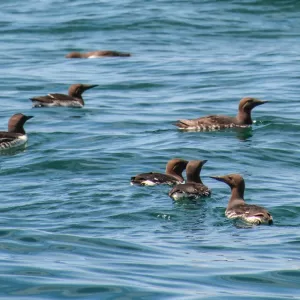 Besides coming ashore to breed, the common murre spends the rest of its life at sea. It can fly short distances but its wings are adapted more suitably for diving and swimming. It feeds on small fish and is only able to catch one at a time in its small beak. Here on the Oregon Coast, juvenile murres are prone to wash ashore during the Fall and Winter seasons. When this happens, it’s usually just because they’re tired, hungry and unable to compete with rough ocean conditions.
Besides coming ashore to breed, the common murre spends the rest of its life at sea. It can fly short distances but its wings are adapted more suitably for diving and swimming. It feeds on small fish and is only able to catch one at a time in its small beak. Here on the Oregon Coast, juvenile murres are prone to wash ashore during the Fall and Winter seasons. When this happens, it’s usually just because they’re tired, hungry and unable to compete with rough ocean conditions.

